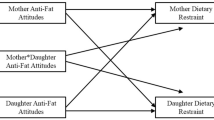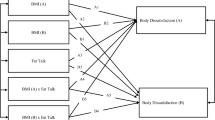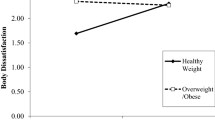Abstract
Purpose
This study examined whether engagement in negative body talk would moderate the association between fear of fat and restrained eating among female friend dyads.
Methods
Female friends (Npairs = 130) were recruited from a Midwestern university in the United States. The dyadic data were examined with an Actor-Partner Interdependence Model (APIM).
Results
Results showed that women’s fear of fat was significantly related to their own restrained eating behaviors. In contrast, women’s fear of fat was not significantly related to their friends’ restrained eating behaviors. Negative body talk was significantly related to restrained eating, as reported by both friends. The interaction between negative body talk and women’s own fear of fat was found to be significant. Although women with less fear of fat showed less restrained eating, engaging in more negative body talk with a friend increased their engagement in restrained eating. Women with more fear of fat engaged in more restrained eating, regardless of their engagement in negative body talk.
Conclusion
Given the detrimental role of body talk between fear of fat and restrained eating, interventions may target reducing body talk among young women.
No level of evidence for
Basic science, Animal study, Cadaver study, and Experimental study articles.


Similar content being viewed by others
References
Fredrickson BL, Roberts TA (1997) Objectification theory: Toward understanding women’s lived experiences and mental health risks. Psychol Women Q 21(2):173–206. doi:10.1111/j.1471-6402.1997.tb00108.x
Smolak L (2004) Body image in children and adolescents: where do we go from here? Body Image 1(1):15–28. doi:10.1016/S1740-1445(03)00008-1
Wiseman CV, Gray JJ, Mosimann JE, Ahrens AH (1992) Cultural expectations of thinness in women: an update. Int J Eat Disord 11(1):85–89. doi:10.1002/1098-108X(199201)11:1<85::AID-EAT2260110112>3.0.CO;2-T
Levitt DH (2003) Drive for thinness and fear of fat: separate yet related constructs? Eat Disord 11(3):221–234. doi:10.1080/10640260390218729
American Psychiatric Association (2013) Diagnostic and statistical manual of mental disorders (5th edn). American Psychiatric Association, Washington, DC
Levitt DH (2004) Drive for thinness and fear of fat among college women: Implications for practice and assessment. J Coll Counsel 7(2):109–118. doi:10.1002/j.2161-1882.2004.tb00242.x
Shapiro S, Newcomb M, Loeb T (1997) Fear of fat, disregulated-restrained eating, and body-esteem: prevalence and gender differences among eight-to ten-year-old children. J Clin Child Psychol 26(4):358–365. doi: 10.1207/s15374424jccp2604_4
van Strien T, Frijters JE, Bergers G, Defares PB (1986) The Dutch Eating Behavior Questionnaire (DEBQ) for assessment of restrained, emotional, and external eating behavior. Int J Eat Disord 5(2):295–315. doi:10.1002/1098-108X(198602)5:2<295::AID-EAT2260050209>3.0.CO;2-T
Webb HJ, Zimmer-Gembeck MJ (2014) The role of friends and peers in adolescent body dissatisfaction: a review and critique of 15 years of research. J Res Adolesc 24(4):564–590. doi:10.1111/jora.12084
Nichter M (2000) Fat talk: what girls and their parents say about dieting. Harvard University Press, Cambridge
Shannon A, Mills JS (2015) Correlates, causes, and consequences of fat talk: a review. Body Image 15:158–172. doi:10.1016/j.bodyim.2015.09.003
Dalley SE, Buunk AP (2009) “Thinspiration” vs. “fear of fat”. Using prototypes to predict frequent weight-loss dieting in females. Appetite 52(1):217–221. doi:10.1016/j.appet.2008.09.019
Shaw H, Ramirez L, Trost A, Randall P, Stice E (2004) Body image and eating disturbances across ethnic groups: more similarities than differences. Psychol Addict Behav 18(1):12–18. doi:10.1037/0893-164X.18.1.12
Davison KK, Markey CN, Birch LL (2003) A longitudinal examination of patterns in girls’ weight concerns and body dissatisfaction from ages 5 to 9 years. Int J Eat Disord 33(3):320–332. doi:10.1002/eat.10142
Dalley SE, Toffanin P, Pollet TV (2012) Dietary restraint in college women: fear of an imperfect fat self is stronger than hope of a perfect thin self. Body Image 9(4):441–447
Wellman JD, Araiza AM, Newell EE, McCoy SK (2017). Weight stigma facilitates unhealthy eating and weight gain via fear of fat. Adv Online Publ Stigma Health. doi:10.1037/sah0000088
Bennett NA, Spoth RL, Borgen FH (1991) Bulimic symptoms in high school females: Prevalence and relationship with multiple measures of psychological health. J Commun Psychol 19(1):13–28. doi:10.1002/1520-6629(199101)19:1<13::AID-JCOP2290190103>3.0.CO;2-Q
Tan CC, Chow CM (2014) Weight status and depression: moderating role of fat talk between female friends. J Health Psychol 19(10):1320–1328. doi:10.1177/1359105313488982
Arroyo A, Harwood J (2012) Exploring the causes and consequences of engaging in fat talk. J Appl Commun Res 40(2):167–187. doi:10.1080/00909882.2012.654500
Jones DC, Vigfusdottir TH, Lee Y (2004) Body image and the appearance culture among adolescent girls and boys: an examination of friend conversations, peer criticism, appearance magazines, and the internalization of appearance ideals. J Adolesc Res 19(3):323–339. doi:10.1177/0743558403258847
Clarke PM, Murnen SK, Smolak L (2010) Development and psychometric evaluation of a quantitative measure of “fat talk”. Body Image 7(1):1–7. doi:10.1016/j.bodyim.2009.09.006
Royal S, MacDonald DE, Dionne MM (2013) Development and validation of the fat talk questionnaire. Body Image 10(1):62–69. doi:10.1016/j.bodyim.2012.10.003
Arroyo A, Segrin C, Harwood J, Bonito JA (2016). Co-rumination of fat talk and weight control practices: an application of confirmation theory. Health Commun. doi:10.1080/10410236.2016.1140263
Chow CM, Tan CC (2016) Weight status, negative body talk, and body dissatisfaction: a dyadic analysis of male friends. J Health Psychol 21(8):1597–1606. doi:10.1177/1359105314559621
Ousley L, Cordero ED, White S (2008) Fat talk among college students: how undergraduates communicate regarding food and body weight, shape, and appearance. Eat Disord J Treat Prev 16:73–84. doi:10.1080/10640260701773546
Rudiger JA, Winstead BA (2013) Body talk and body-related co-rumination: associations with body image, eating attitudes, and psychological adjustment. Body Image 10(4):462–471. doi:10.1016/j.bodyim.2013.07.010
Corning AF, Gondoli DM (2012) Who is most likely to fat talk? A social comparison perspective. Body Image 9(4):528–531. doi:10.1016/j.bodyim.2012.05.004
Kenny DA, Kashy DA, Cook WL (2006) Dyadic data analysis. Guilford, New York
Crandall CS (1994) Prejudice against fat people: Ideology and self-interest. J Pers Soc Psychol 66(5):882–894. doi:10.1037/0022-3514.66.5.882
Campbell LJ, Kashy DA (2002) Estimating actor, partner, and interaction effects for dyadic data using PROC MIXED and HLM5: a brief guided tour. Personal Relatsh 9:327–342
Aiken LS, West SG (1991) Multiple regression: testing and interpreting interactions. Sage, Newbury Park
Sharpe H, Naumann U, Treasure J, Schmidt U (2013) Is fat talking a causal risk factor for body dissatisfaction? A systematic review and meta-analysis. Int J Eat Disord 46(7):643–652
Tapper K, Pothos EM (2010) Development and validation of a food preoccupation questionnaire. Eat Behav 11(1):45–53. doi:10.1016/j.eatbeh.2009.09.003
Stommel M, Schoenborn CA (2009) Accuracy and usefulness of BMI measures based on self-reported weight and height: findings from the NHANES & NHIS 2001–2006. BMC Public Health 9(1):421. doi:10.1186/1471-2458-9-421
Hart E, Chow CM, Tan CC (2017). Body talk, weight status, and pathological eating behavior in romantic relationships. Adv Online Publ Appetite. doi:10.1016/j.appet.2017.06.012
Author information
Authors and Affiliations
Corresponding author
Ethics declarations
Conflict of interest
On behalf of all authors, the corresponding author states that there is no conflict of interest.
Ethical approval
All procedures performed in studies involving human participants were in accordance with the ethical standards of the institutional and/or national research committee and with the 1964 Helsinki declaration and its later amendments or comparable ethical standards.
Informed consent
Informed consent was obtained from all individual participants included in the study.
Appendix: Hypothetical dyadic “double-entry” data
Appendix: Hypothetical dyadic “double-entry” data
Person A fear of fat | Person B fear of fat | Person A restraint | Person B restraint | Body talk | |
|---|---|---|---|---|---|
Dyad 01 | 5 | 4 | 1 | 2 | 3.2 |
Dyad 01 | 4 | 5 | 2 | 1 | 3.2 |
Dyad 02 | 3 | 2 | 4 | 3 | 2.8 |
Dyad 02 | 2 | 3 | 3 | 4 | 2.8 |
Dyad 03 | – | – | – | – | – |
Dyad 03 | – | – | – | – | – |
Rights and permissions
About this article
Cite this article
Chow, C.M., Ruhl, H., Tan, C.C. et al. Fear of fat and restrained eating: negative body talk between female friends as a moderator. Eat Weight Disord 24, 1181–1188 (2019). https://doi.org/10.1007/s40519-017-0459-9
Received:
Accepted:
Published:
Issue Date:
DOI: https://doi.org/10.1007/s40519-017-0459-9




